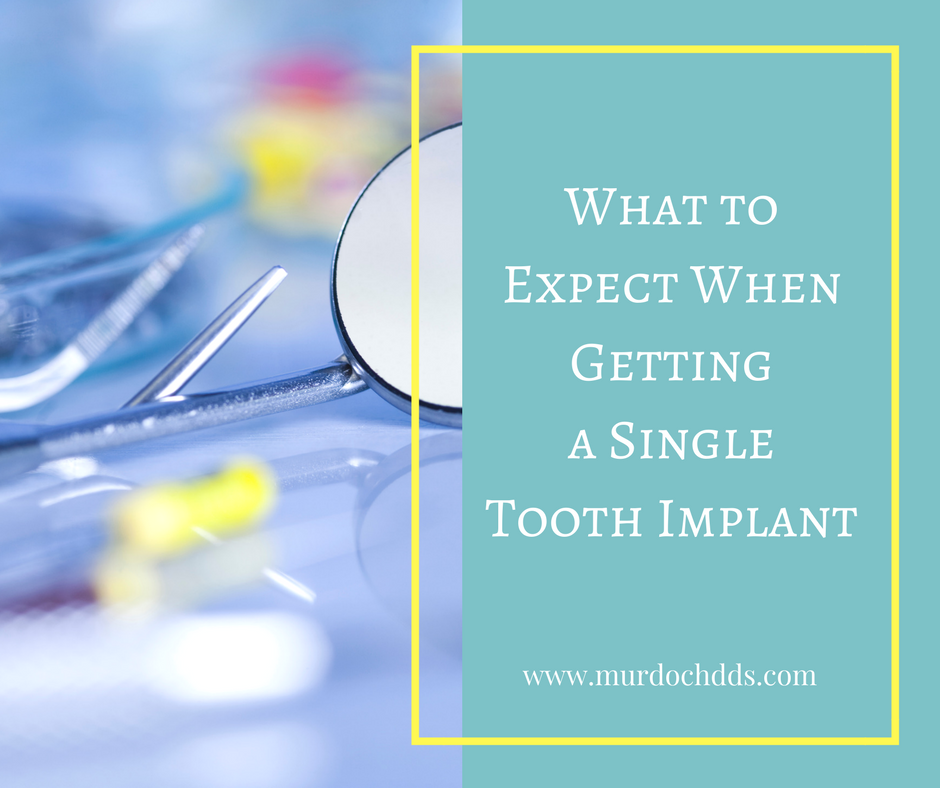What to Expect When Getting a Single Tooth Implant

If you’ve made the decision to get a dental implant, you may be experiencing some apprehension about the upcoming procedure. What will happen? Will it hurt? How long will it take to heal afterward? Take a deep breath – getting a dental implant is a lot less painful and stressful than most people realize. We have a tendency to make things much bigger in our minds when we don’t know what to expect, therefore learning what’s to come can go a long way toward feeling comfortable with an upcoming implant procedure. Here’s what you can expect, step-by-step:
Step One: Get X-Rays
For evaluative and prognostic purposes, your dentist will first need to take x-rays of the area where the implant will be placed. This is mostly to get a good look at the condition of your bone structure and your gums—both of which will have a big impact on the success of the implant.
Step Two: Get Impressions Made
Next, your dentist will need to make impressions of your mouth so that they will be able to work with an accurate replica of your teeth, gums, and tissues. They will fill a U-shaped tray with a soft liquid and ask you to bite down on the tray for about one to two minutes. While most people do not have a problem with this part of the process, it may be slightly uncomfortable if you have a sensitive gag reflex or do not like the feeling of not being able to open your mouth. If this is the case, be sure to address your concerns with your dentist before beginning, take lots of deep, meditative breaths through your nose during the process, and try to concentrate on something else. It’ll be over before you know it.
Step Three: Tooth Extraction
If the tooth that is being replaced is still in your mouth, the next step will be to extract it. Your dentist and their team will ensure a pain-free process, and all you should feel is some tugging or pressure during the procedure. This sometimes happens immediately before the implant procedure.
Step Four: Implant Placement
The next step is the placement of the implant itself. First, your dentist will drill a hole into the jawbone where the implant will be placed. They will then insert the implant into the hole. This becomes the “root” for your artificial tooth. This process is not generally painful at all, and feels much like having a cavity filled. Depending on your bone structure, a bone graft may be required before inserting the implant, but rest assured it is quick and painless and you likely won’t even know it’s being done.
The implant placement appointment will take between one and two hours. Afterward, you’ll be free to go about your day as usual, but you may be required to stick to soft foods for up to a week. You can also expect some tenderness, and possibly swelling, in the days to come. Your dentist will direct you on management of pain and swelling.
Step Five: Placement of the Abutment and Permanent Crown
Typically, your dentist will wait for your jawbone to fuse with the implant before they place the abutment, a process that can take weeks (and sometimes months) to happen. But it’s important to wait until it’s ready, because you want the implant to be very stable and to really last. Once your dentist has determined that the implant is stable, they will place and tighten the abutment onto the implant. Again, this will not likely be painful at all – the most you should feel is a bit of pressure.
Once the abutment is on good and tight, the dentist will place the permanent crown. You will now have a strong, secure, artificial tooth. With today’s advanced materials, this tooth will look like your other teeth, and you’ll be able to chew on it as you would with any other tooth. With proper oral hygiene, regular checkups, and taking care not to bite down on hard objects, your implant should last a very long time.
To learn more about dental implants, visit Dr. Richard Murdoch at https://murdochdds.com/.
Dr. Murdoch serves patients in the Centennial and Glendale areas of Denver, Colorado.
January 22, 2018
